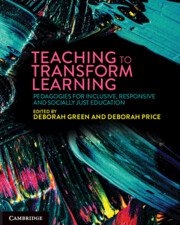Book contents
- Teaching to Transform Learning
- Acknowledgement of Country
- Teaching to Transform Learning
- Copyright page
- Contents
- Contributors
- Acknowledgements
- Introduction Understanding the learner to inform educators’ implementation of pedagogical approaches to transform learning
- Part 1 Pedagogies for all
- Part 2 Engaging pedagogies: making the curriculum come alive for all learners
- 8 Redesigning pedagogy for transformation: creative body-based learning
- 9 Building transformative classrooms through visual and creative body-based learning design
- 10 Co-constructed early childhood pedagogies
- 11 Strengths-based, learner-centred pedagogies: the voice of learners in co-creation and co-design
- 12 Pedagogy informed by community expertise
- 13 Nature-based approaches enhancing experiential learning
- 14 Beyond the four walls
- Part 3 Empowering pedagogies: 21st-century skill development and 22nd-century futures thinking
- Index
- References
11 - Strengths-based, learner-centred pedagogies: the voice of learners in co-creation and co-design
from Part 2 - Engaging pedagogies: making the curriculum come alive for all learners
Published online by Cambridge University Press: 25 October 2024
- Teaching to Transform Learning
- Acknowledgement of Country
- Teaching to Transform Learning
- Copyright page
- Contents
- Contributors
- Acknowledgements
- Introduction Understanding the learner to inform educators’ implementation of pedagogical approaches to transform learning
- Part 1 Pedagogies for all
- Part 2 Engaging pedagogies: making the curriculum come alive for all learners
- 8 Redesigning pedagogy for transformation: creative body-based learning
- 9 Building transformative classrooms through visual and creative body-based learning design
- 10 Co-constructed early childhood pedagogies
- 11 Strengths-based, learner-centred pedagogies: the voice of learners in co-creation and co-design
- 12 Pedagogy informed by community expertise
- 13 Nature-based approaches enhancing experiential learning
- 14 Beyond the four walls
- Part 3 Empowering pedagogies: 21st-century skill development and 22nd-century futures thinking
- Index
- References
Summary
The purpose of this chapter is to highlight the centrality of children and young people in the learning process and identify educational approaches that emphasise the importance of ‘learner voice’. Opening avenues for consultation, participation and collaboration with learners in the design of curriculum, pedagogy and assessment can be significant in enhancing their engagement, achievement and wellbeing. That is, attention to the humanistic, agentic and cognitive attributes of learners, understanding their culture and lifeworlds, empowering learners to exercise agency and valuing their knowledge and skills contributes to the co-creation of meaningful learning experiences (Morrison et al., 2019; Price et al., 2020).
- Type
- Chapter
- Information
- Teaching to Transform LearningPedagogies for Inclusive, Responsive and Socially Just Education, pp. 171 - 186Publisher: Cambridge University PressPrint publication year: 2024

